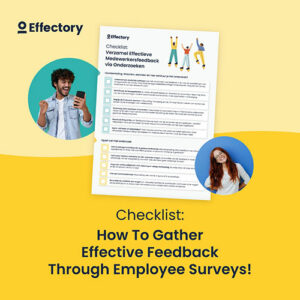How you communicate your engagement or pulse survey to your employees, stakeholders, and managers will directly impact the response rate and success of the results. Well thought out communication before, during and after the survey is key to gaining support and action. This article provides you with practical steps on how to create a successful engagement survey communication plan.
Step #2 Communicating your employee engagement survey

The importance of engagement survey communication
Your survey’s success depends on how well you communicate with your people during every phase of the process.
Promoting your employee engagement survey across the organization and individually to key stakeholders as early as possible is a must for gaining support and creating feedback ambassadors. Having a select handful of influential people involved from the beginning of the engagement survey communication will favourably affect the response rate once the survey is underway.
Step #1: Preparing your employee survey (part 1)
If people feel involved in the survey, they will be more willing to act on the results, which is in essence the whole point of the exercise. If you do not communicate clearly with employees on important issues (such as anonymity, timing, expectations, etc), they may resist or fail to see the importance of such a project. In the worst case, employees won’t trust the survey and could even sabotage the survey by deliberately giving misleading answers.
Here are tips and suggestions for effective communication before, during and after the survey.
How to gather feedback from your employees
The definitive checklist for creating your employee engagement survey.
DownloadCreating an employee survey project plan
A simple place to start your engagement survey communication is by determining:
- what you want to communicate,
- to whom,
- in what way, and
- when you want to share the information
6 key criteria to find the right employee engagement survey provider
Pre-survey communication
Your employees need to know why you are conducting the survey and what the benefits will be if they support the intiative (i.e. ‘what’s in it for me’). You should begin promoting your employee engagement survey long before launch day – preferrably with the help of an internal marketing campaign.
In your employee engagement survey communication let your people know what to expect from the survey at each stage. Make it relevant and prepare them not only for providing their feedback, but also for acting on the results and insights obtained. Start with organization-wide communication across various channels.
Ensure that you clearly communicate the following:
- Start date of the survey
- Planning schedule
- Intended outcomes and action plan
- Guarantee of anonymity
- Deadline for providing feedback
- Channels for asking questions
- How and when results will be announced
- Follow up process
Include details such as who is eligible to provide feedback, how to access the survey, what will be measured and which method you will use.
The survey will not be considered an immediate priority without the support of your stakeholders and ambassadors, so ensure that you provide them with clear expectations on what they need to do to encourage participation.
Step #1: Preparing your employee survey (part 2)
Designing communication materials
Make use of your marketing team to give life to your employee engagement survey communication. Here are some creative ideas on how to brand and promote the survey:
- Printed invitation
- Poster
- Flyer
- Internal magazine
- Intranet
- On-screen pop-up
- Attending team meetings
- Introductory video
- Presentation
Launching an employee engagement survey
All participants should receive a survey package, whether the survey is to be completed online, on a mobile device or, for industries in which online access is limited, on paper. For online surveys, the survey should be accompanied by instructions, expectations and a reminder of the purpose and process.
For manual surveys, your employees should receive an envelope containing the questionnaire and an accompanying letter. In the letter you should once again explain what is expected of the employees and why. Don’t forget to include an anonymity guarantee, and for further details, you can also to include a pamphlet explaining the background and purpose of the survey. Complete the package by including the postage-paid envelope also makes it easier for employees to return the questionnaire if needed.
During the survey
Engagement survey communication on launch day reinforces all the preparation you’ve done but once the survey is live, give your people the space to engage with the survey as they see fit. You won’t likely get 100% participation but it is important to track the response daily and showcase the following on screens or via email:
- The response rate thus far
- Which departments have the highest level of participation
- How much time is left to provide feedback
Inform managers or survey ambassadors on the reposnse rate every three or four days and ask them to highlight the survey during team meetings. If participation is disappointing, send email reminders, or resend the survey invitation. Make use of your organization’s social channels. With 24 hours to go, a final reminder may trigger any well-meaning procrasinators into action!
Employee Engagement Survey
Run your engagement survey and gather feedback from your employees. Discover Effectory’s engagement survey action planning template.
view solutionEmployee satisfaction survey results communication
Collecting the results is only the start line for achieveing the end goal of your employee engagement survey. At this point it is vital to keep the momentum going. Start by thanking those who participated. Share the employee satisfaction survey results transparently across the organization as soon as possible, and outline the areas for improvement that emerged from their feedback.
In larger organizations, you may want to tier the results and tailor the data to different audiences. In these instances, communicate the process ahead of the results to maintain interest.
Sharing details on how the feedback will be used for action planning will not only help generate support and engagement in the follow-up period, but also show your people that their feedback is meaningful and useful. After all, your people are the ones who will need to make changes to realise those improvements. In addition, it also has a positive effect on the response generated during the next survey.
You may want to plan the next employee survey after a certain time period to track progress. A culture of feedback can drive agility, growth and innovation in your organization.
Read more
Read the whole series on how to create engaging employee surveys:
- Step #1: Preparing your employee engagement survey (part 1)
- Step #1: Preparing your employee engagement survey (part 2)
- Step #2: Communicating your employee engagement survey
- Step #3: Implement your employee engagement survey with impact
- Step #4: Analysing your employee engagement survey
- Step #5: Taking action!
Book a free demo. See our solutions in action.
Effectory is Europe’s Leading provider of Employee Listening Solutions. Schedule a product demo and discover how to enhance your employees’ engagement.
Demo request
